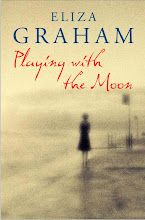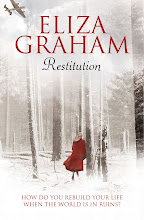Brighton Argus
Playing with the Moon
Eliza Graham
Pan Macmillan
Minna and Tom rent a cottage in a small village near Dorset, hoping the change of scene will help them deal with the recent loss of their son.
Exploring the beach, the unearth a skeleton that belonged to an American GI posted there during the Second World War. What seems to be nothing more than a strange discovery starts having a deeper impact on Minna, as she traces the GI's history with the help of a local woman she befriends.
The story is engaging, with time divided equally between past and present day. Although the ending won't surprise, it makes for an emotional read.
Friday 29 February 2008
Wednesday 6 February 2008
The Irish Book Review
STRANGE MEETINGS
Playing with the Moon
Eliza Graham
Autumn 2007Playing with the Moon
Eliza Graham
Eliza Graham's first novel, Playing with the Moon, is an intricately plotted work, shifting between the present and past, and between two different narrative voices, Minna, guilt ridden over the death of her young son in a car accident and trying, not very hard, to save her two-year marriage, tells her own story. The story of Felix, short for Felicity, her childhood, the events leading up to the tragedy in 1943 and the long-term consequences of that tragedy, is told in the third person. These two narratives intersect early on through the Dorset setting itself--Felix's childhood home, Rosebank House, now a restored holiday home rented by the young couple,and through the discovery of the skeleton of a missing GI from the Second World War.
The intersections and interweaving of past and present are carefully worked, as the details about the tragedies from which all the characters are trying to recover are slowly released. Minna and Tom's macabre discovery of the skeleton on the beach in the first chapter of the novel becomes both motif and metaphor for both narratives, which start off with a series of unknowns and connect as the characters work through loss, mourning and the possibility of survival.
Of the two plots, the discovery of the dead GI is initially more compelling, partly because it is clear early on that it is a murder mystery and that the adult Felix knows more about it than even her childhood memories allow. The story of the skeleton, as it is unravelled, is the story of a traumatic and life-changing period in Felix's childhood and it touches on the history of the training black American soldiers for the Normandy landings,evacuation and the commandeering of a remote village by the MOD. On the other hand, Minna's growing obsession with the dead soldier seems at odds at times with her grieving and self destructive frame of mind, manifesting itself through her refusal to eat.
While the intersections of the past and present are well paced, the plot does verge on the breathless at times,especially in the Felix narrative, which touches not only on racist attitudes and murder, but hidden identities,marriages of convenience,gay sex, blackmail,abortion and more. Ends are tied up neatly -- perhaps too neatly. But in its attempt to capture forgotten fragments of history through Felix's story and the devastating impact of the loss of a child through Minna's story,the novel is probing, sensitive and moving.
Subscribe to:
Posts (Atom)


